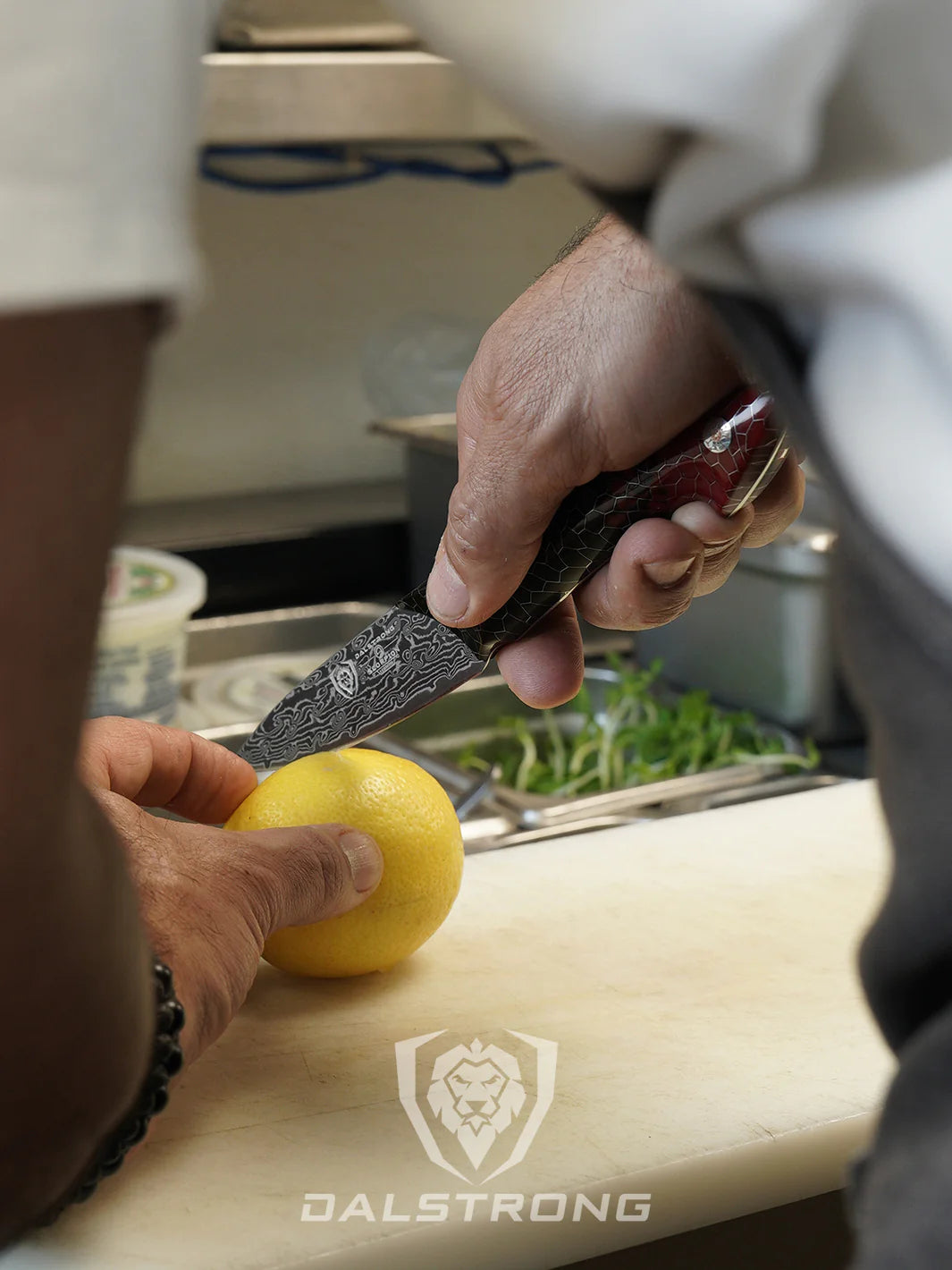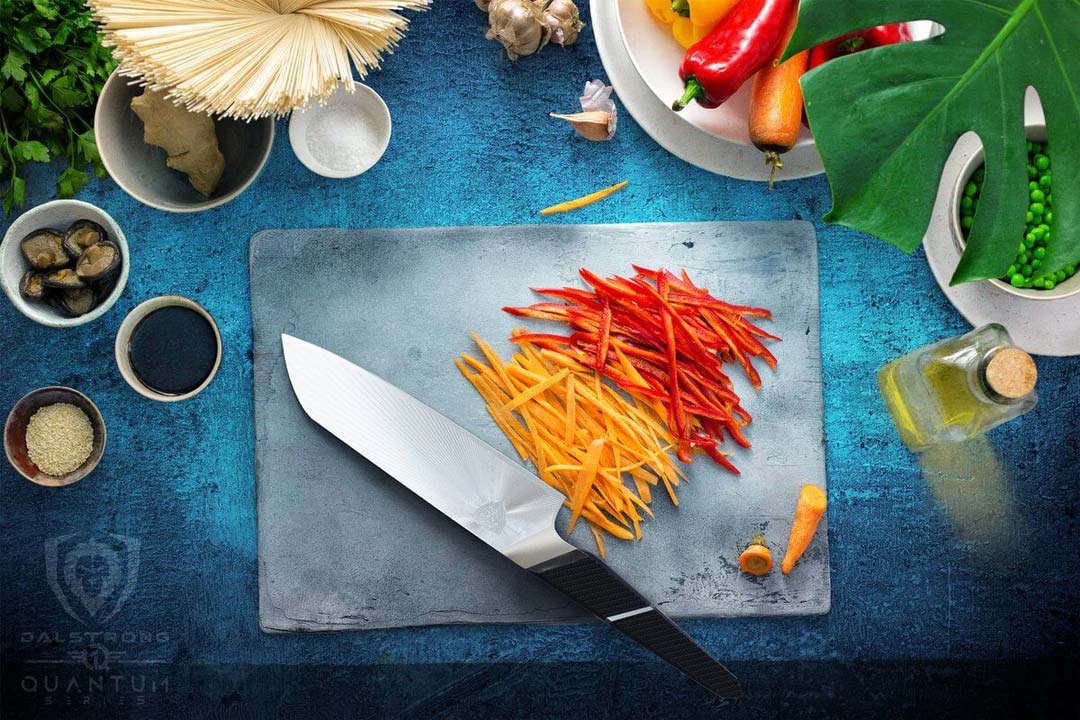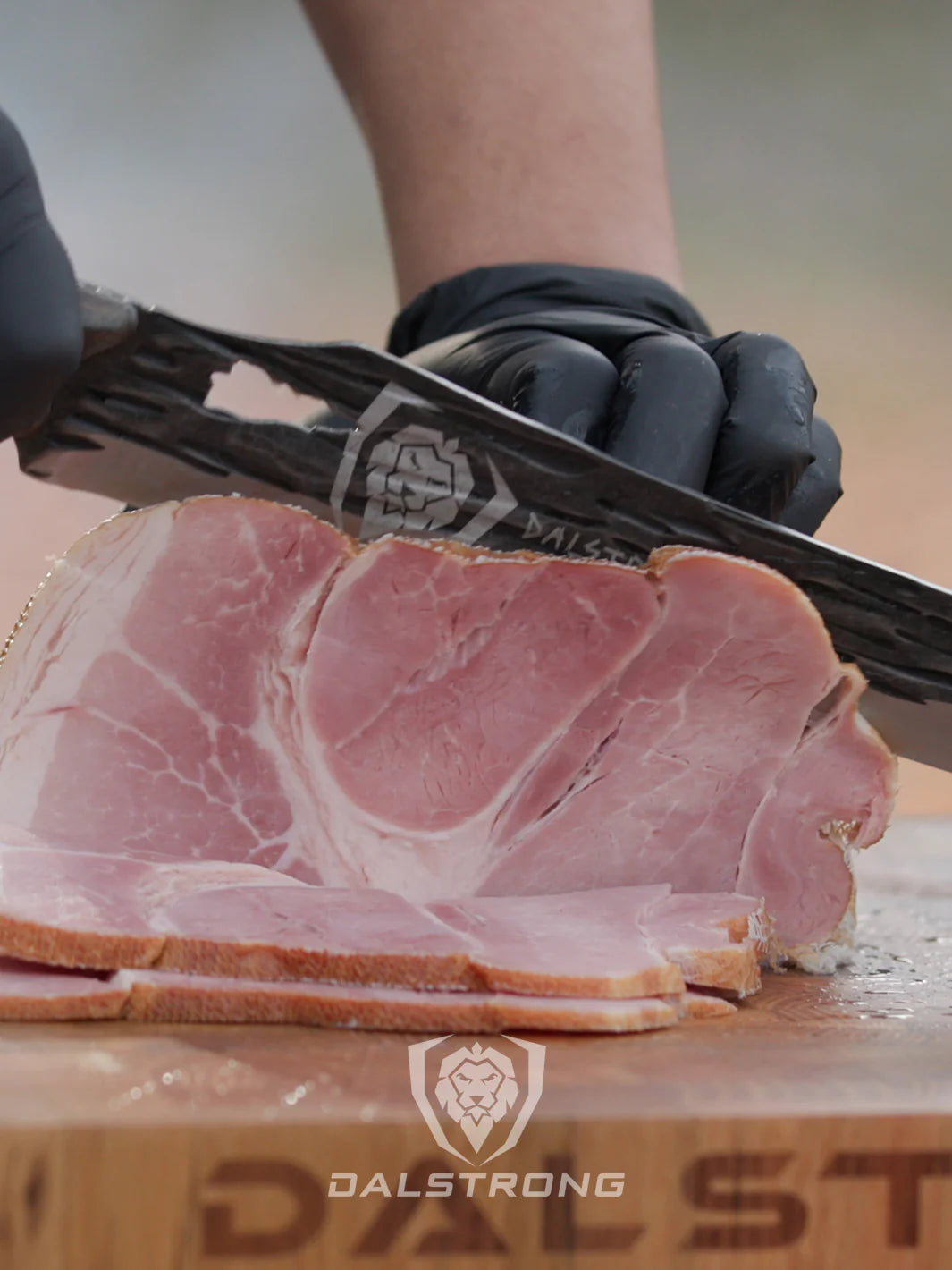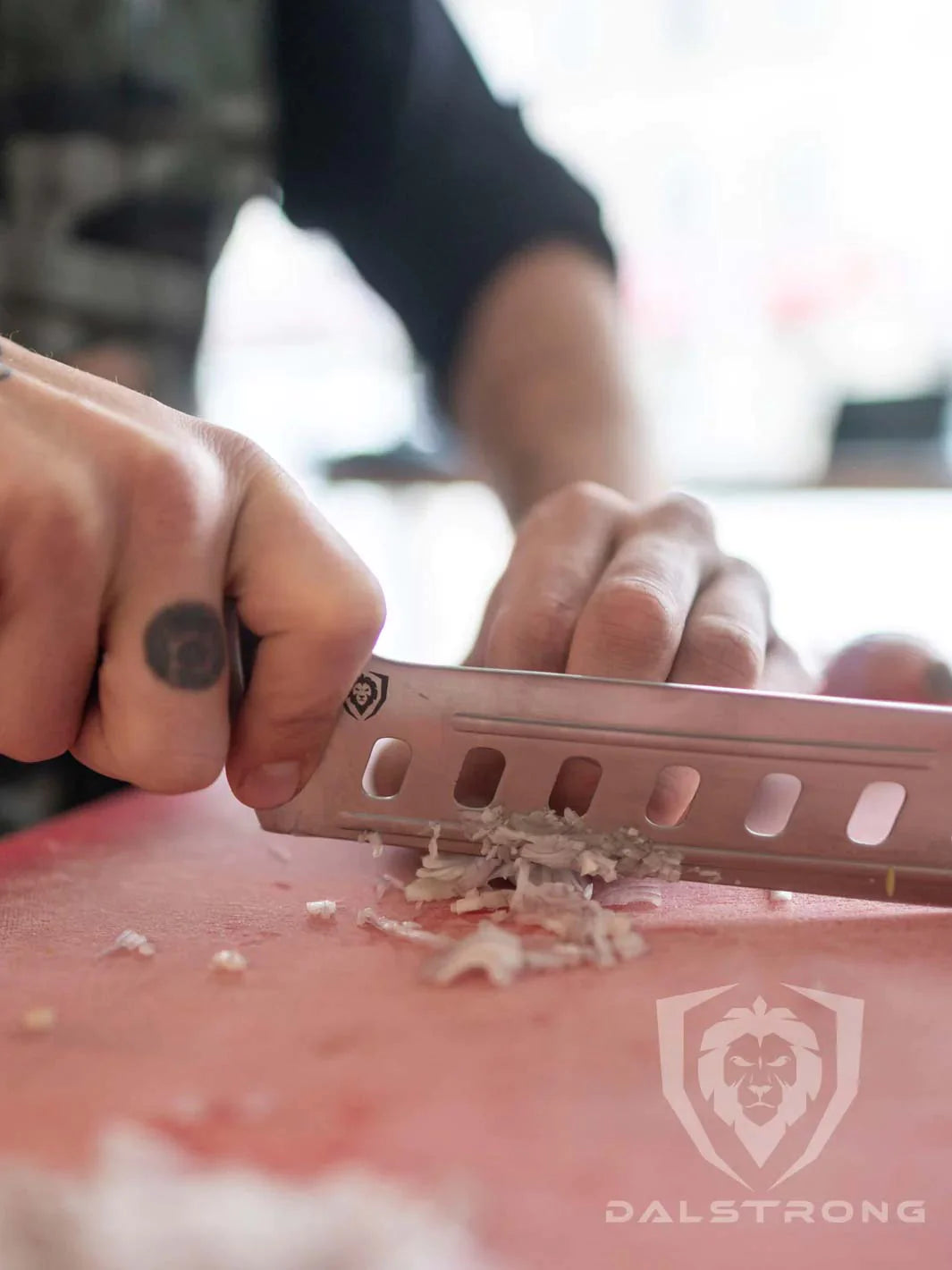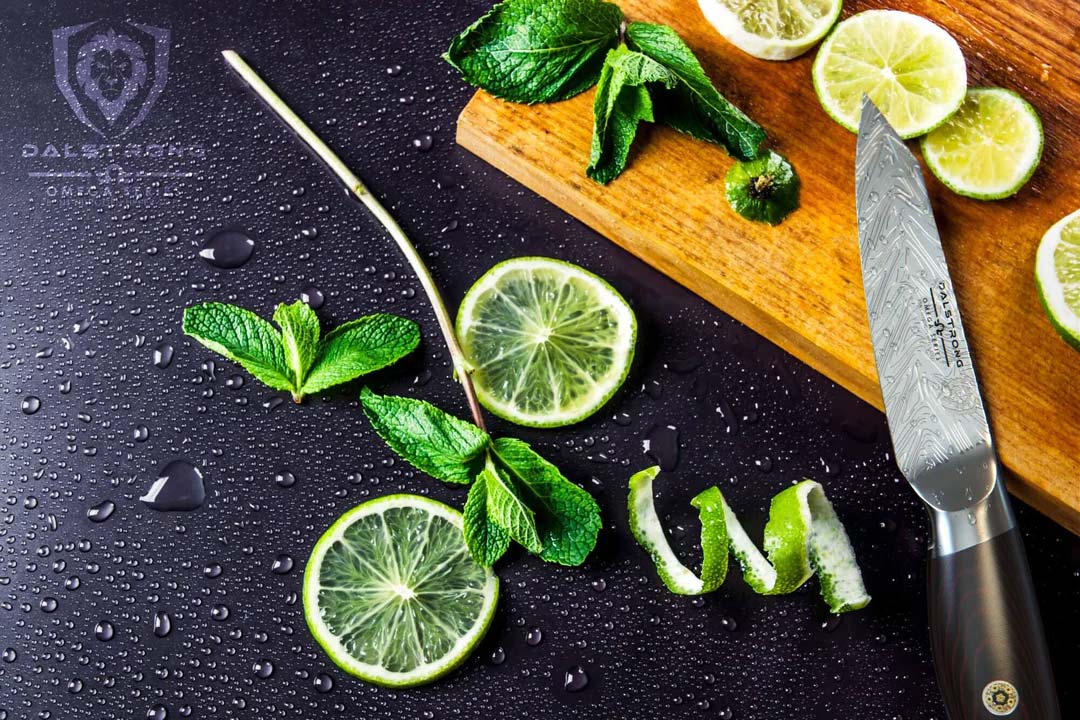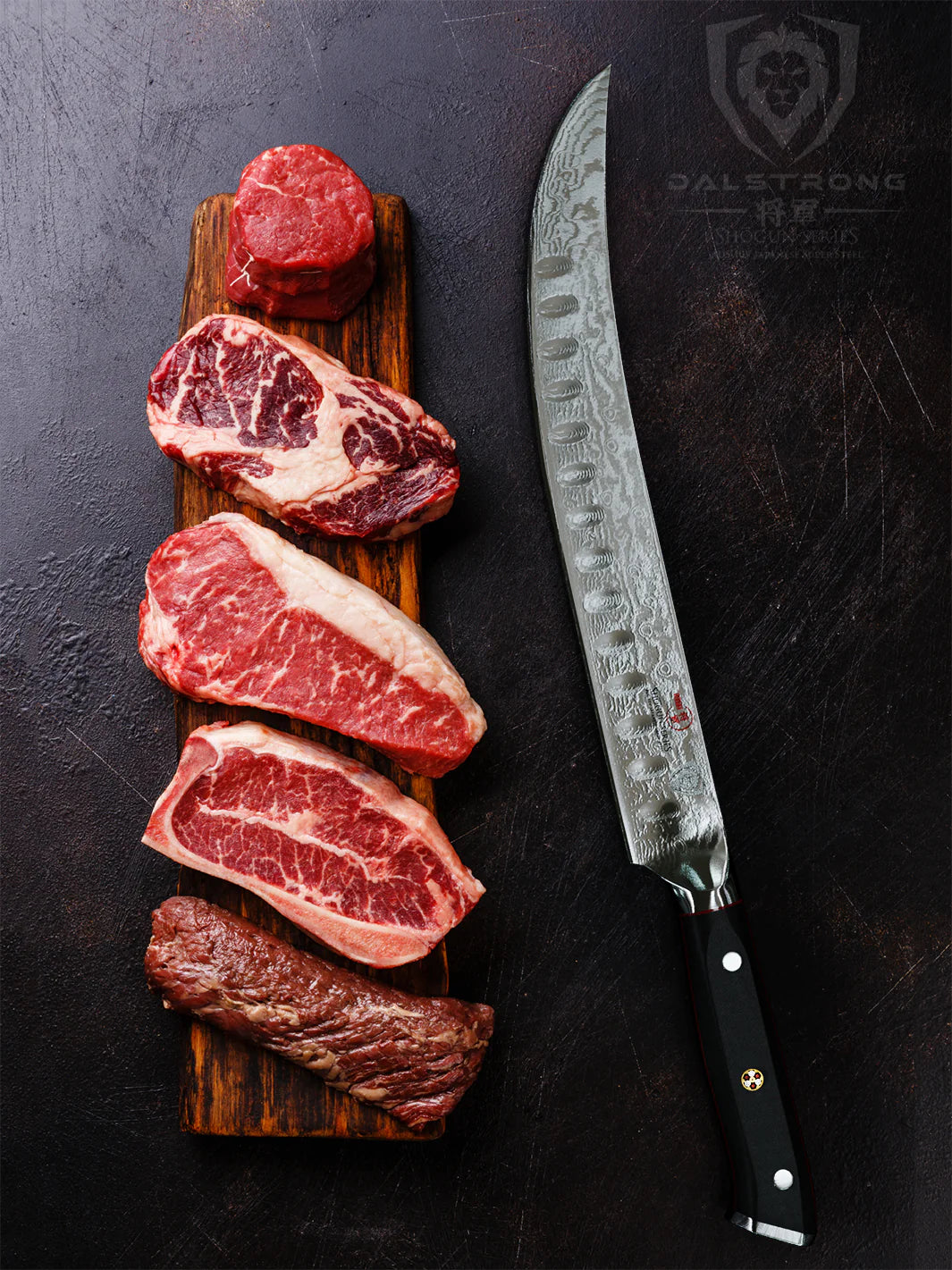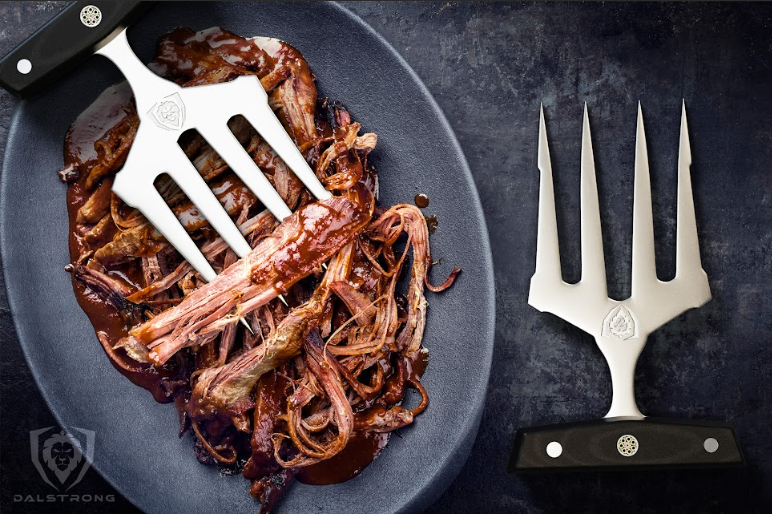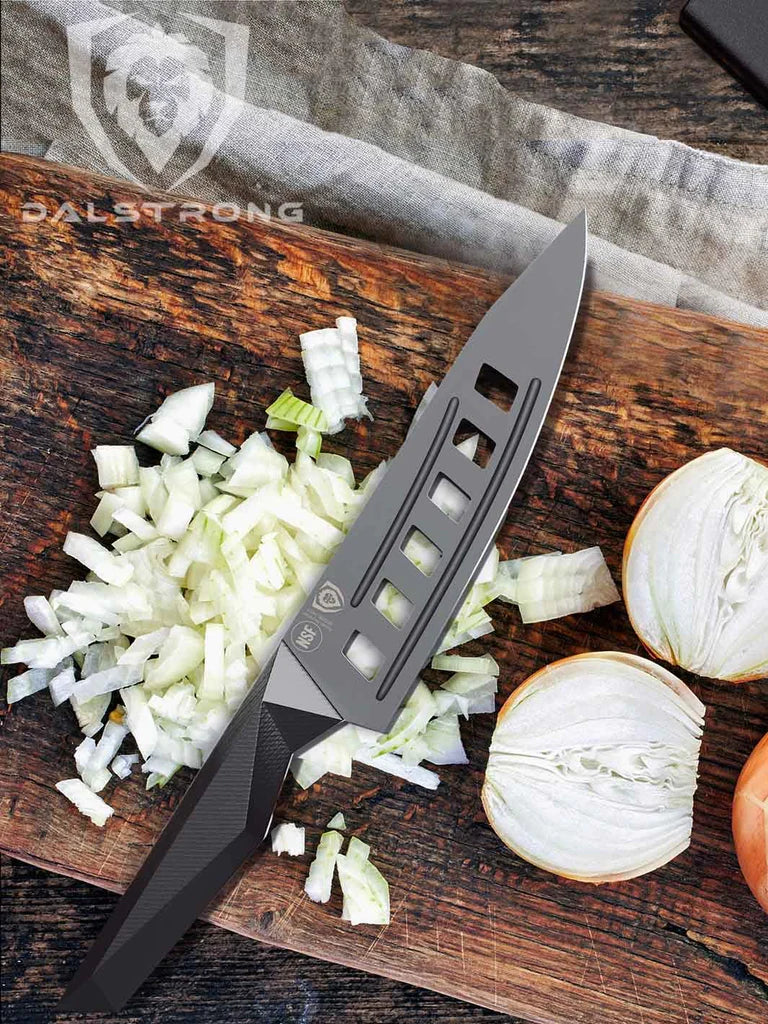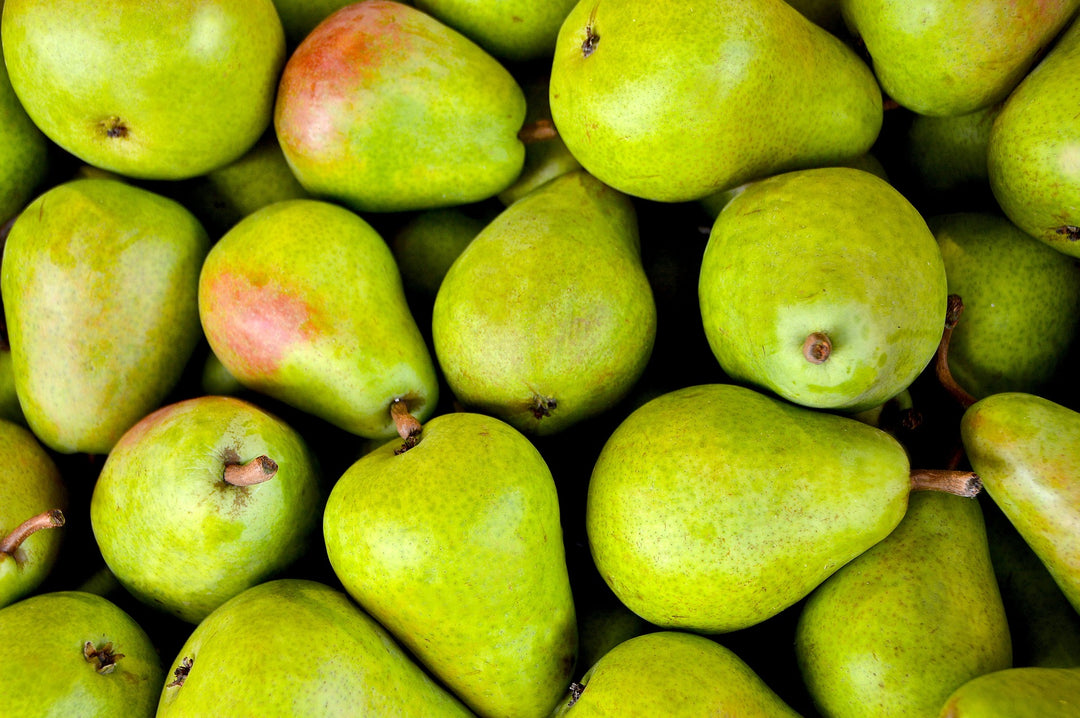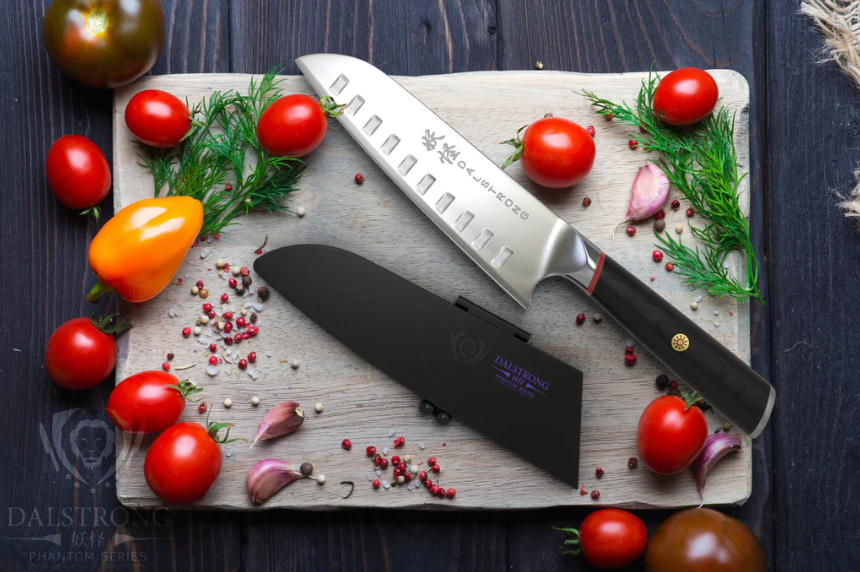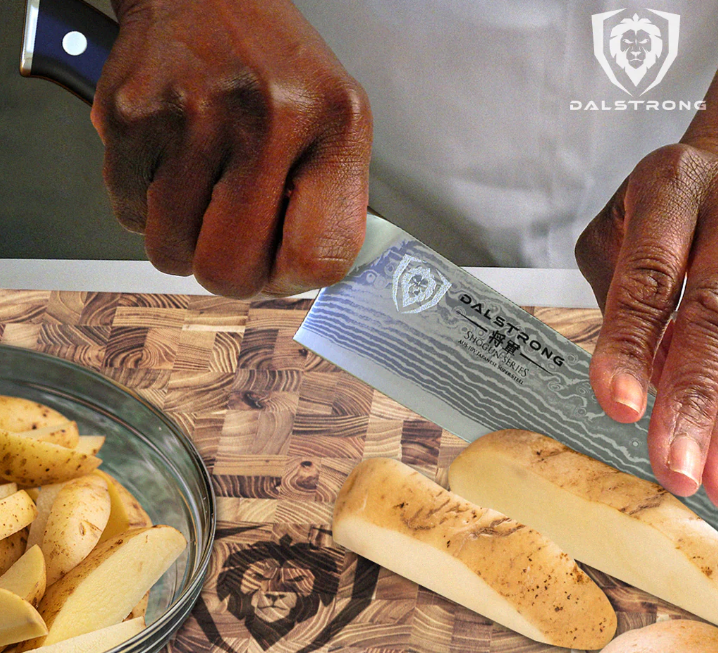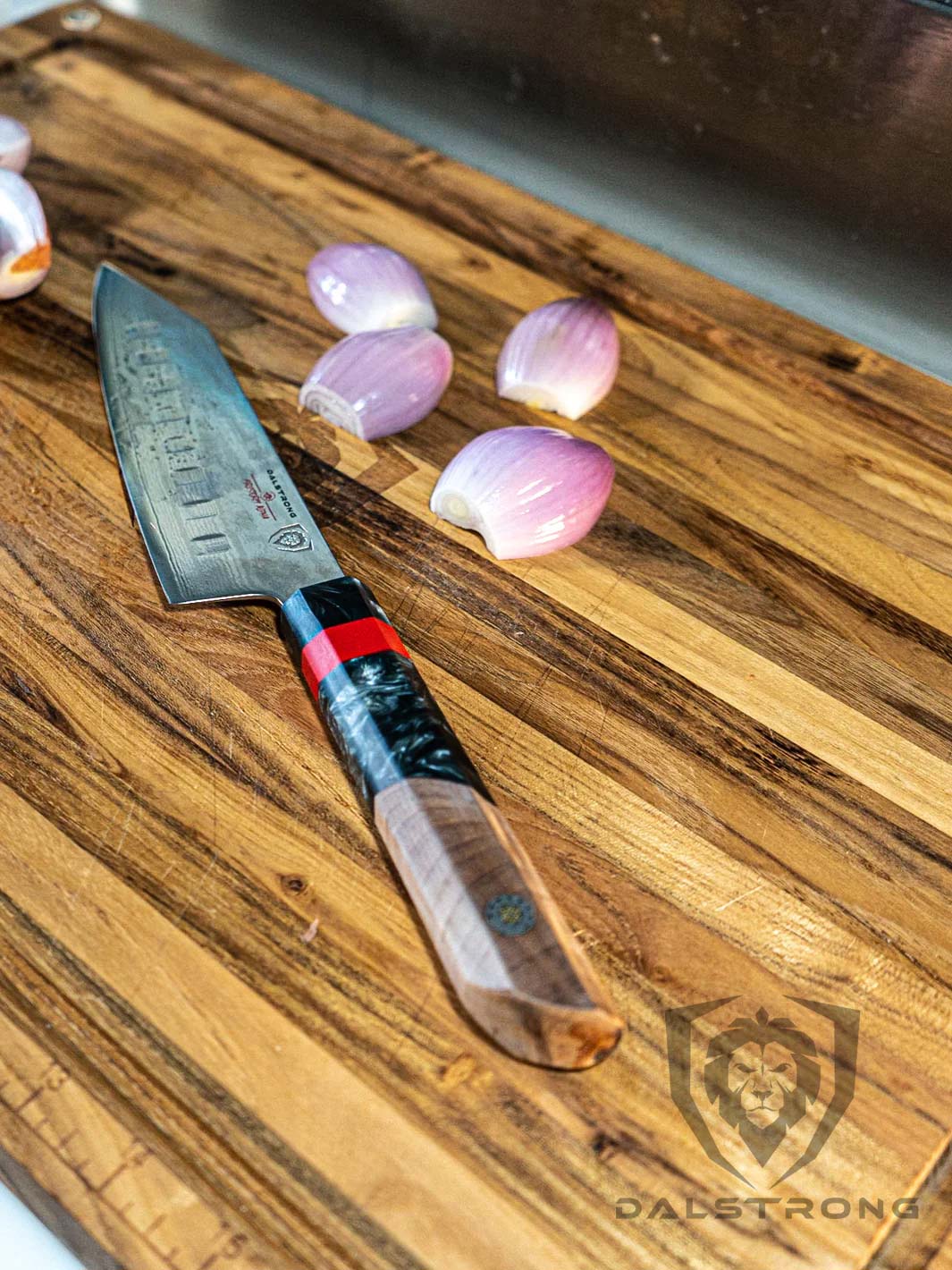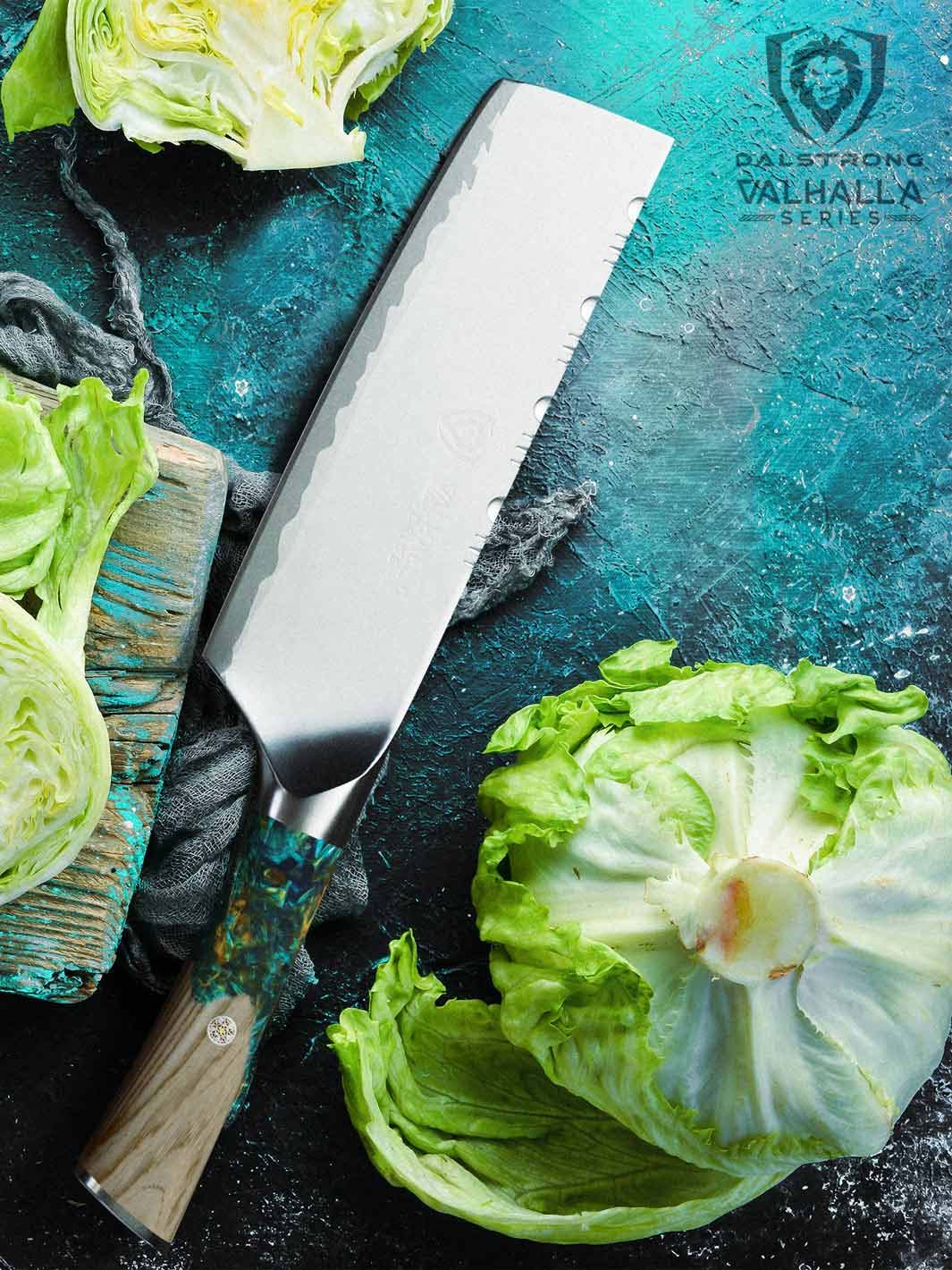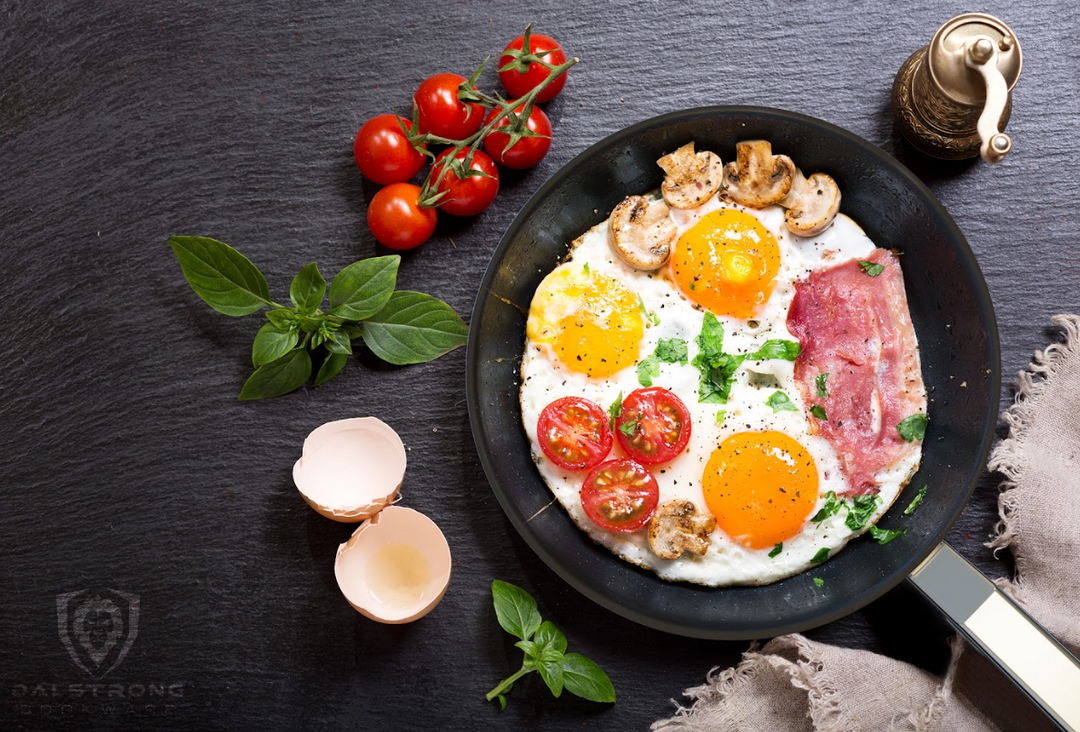What Is A Julienne Cut And How To Do It Like A Chef
 Chef's Knife 9.5" Shogun Series
Chef's Knife 9.5" Shogun Series
Quick-Step Overview: How To Do Julienne Cut
- Wash your vegetables, and pat dry with a paper towel.
- Once your vegetable is dry, place it on a cutting board and use a vegetable peeler to peel the skin off of the vegetable.
- Then, at a crosswise angle, cut lengthwise into 2½ to 3½ inches.
- If the vegetable is round, start by cutting a thin slice off from one side of the vegetable. Doing this helps create a stable base and will prevent the vegetable from slipping.
- Next, using a paring knife, slice lengthwise into 1/16-1/8 inch thick slabs.
- Holding firmly onto the base of the vegetable cut into thin strips.
- Now, slice the thick slabs into thin strips one at a time and continue to cut them lengthwise with a sharp knife, preferably a chefs knife.
1. What Is a Julienne Cut?
‘Julienne’ is a French term for cutting techniques that help achieve uniformed, precise, and thin strips of vegetables. ‘Matchstick cut’ is another name for julienne cut. The idea is to achieve uniform slices of vegetables to help food cook evenly. Using julienned vegetables for cooking also helps in decreased cooking time as the heat can probe through the vegetable easily.When you need julienned vegetables, you should select a sharp knife. If your knife has a dull blade, you can use whetstones to sharpen it. If for instance, you’re cutting an onion, you want to make sure that you have a flat surface on it so it does not slip away from under your chefs knife.
The trick to achieving julienned vegetables with ease is by starting with a series of parallel cuts that are equally spaced from one another. Then, flip the vegetable and repeat the process. In the end, you should have a pile of even and uniform strips.
 The Culinary Commander Top-Grain Leather | Professional Chef's Kitchen Apron
The Culinary Commander Top-Grain Leather | Professional Chef's Kitchen Apron
2. Knives Used for Julienne Cuts
I have used both a mandoline and a knife for julienned vegetables like ginger and cucumber to make an immunity booster drink. While mandolines may seem quicker, a sharp knife shouldn’t be underestimated. Mandolines are heavier than knives and cause wrist fatigue, as well as a higher chance of hurting yourself as it has a large surface of sharp grooves than can cause cuts and wounds.And hey, no one wants that when they’re in the middle of meal prep. Let’s get into discussing the perks and perils of using a mandoline.
3. Knives vs. Mandolins
There are various kitchen tools used to achieve even and precise cuts for julienned vegetables. Some of them include a Nakiri knife, a Santoku knife, a Mini cleaver knife, and a mandolin. Let’s dive deeper into each one of these kitchen tools and see what they bring to the table.
Nakiri Knife
A Nakiri knife is a Japanese-style knife mainly used to chop, mince and slice vegetables. It originated many centuries ago and gained popularity with its perfect use in cutting all kinds of vegetables.
The blade of a Nakiri knife is rectangular and is meant for the push/pull chopping of vegetables. With Nakiri, you can use an up and down motion or slice forward and back, but no rocking. Most Nakiri knives have a full tang for sturdiness, which also makes them perfect to produce uniform and clean cuts on the vegetables.
Santoku Knife
Named after the 3 virtues of mincing, slicing, and dicing, the Santoku knife makes an excellent kitchen tool for achieving julienned vegetables. The bevel of this knife is steep and sharp and helps get clean, crisp, and thin slices.
Mini Cleaver Knife
Mini cleaver knives are perfect for vegetables such as chili, ginger, and peppers. It can help achieve julienned vegetables for garnish or sauces. The weight of a mini cleaver knife ensures a smooth glide through any vegetable. It also keeps the thin slices of vegetables crisp, sharp, and clean. Especially root vegetables such as carrots and ginger.
Mandolins
With mandolins, there is a risk of injuring your finger as the tiny, and sharp grooves on the surface of a mandolin are extremely pointy. Gliding a vegetable quickly on its surface will only increase the risk of injuring yourself.
They also take up more room on kitchen counters and cutting boards, especially if you have a small kitchen space. Mandolins don’t come equipped with food holders and tend to slip and slide, even on wood cutting boards. They also don’t offer any finger protection.
Dalstrong’s range of knives embodies function meeting form. Whether you’re looking for a Santoku knife, Nakiri knife, paring knife, or a mini cleaver knife, Dalstrong has you covered. And, if you want to pair your knife with premium quality cooking tools or cookware, they’ve got your back there, too. So, it is safer to choose knives over mandolins as cooking tools to get julienned vegetables.
4. Easy Knife Techniques for Julienne Cuts
Achieving julienned vegetables is easy when you have a sharp knife, especially a chefs knife or a paring knife on your kitchen block. The most common vegetables to get a julienne cut on are onions, carrots, zucchini, celery, and ginger.
Here are some easy-cutting techniques to achieve julienned veggies.
How to Julienne an Onion
- Remove the outer peel or skin.
- Chop the two pointed ends of the onion with a sharp knife.
- Slice the onion in half and cut until it reaches an 18inch thickness.
- Place one-half of the onion on any of your wooden cutting boards.
- Angle your paring knife at 45º degrees and slice it into thin strips.
- When you reach the middle section of the onion, alternate the angle at 90º degrees for the smaller pieces of the vegetable.
- Continue to cut them lengthwise, and flip the onion when it starts to get a little unstable.
- Trim the uneven ends and continue to cut lengthwise.
There you have it! Elegant, julienned red onions, perfect for your next salad.
Cooking Tip:
- Cut off any uneven or unstable bits of the red onion and julienne them at the very end.
How to Julienne Carrots
- Peel your carrots on a cutting board and cut them into lengths of 2” - 3” inches.
- Cut a thin slice from the carrot and trim it with a sharp knife for a stable base.
- Place the carrot flat side down and cut it into thin strips, ideally, they should be 1/16 - 1/8 inch in thickness.
Cooking Tip:
- Working with baby carrots would produce minimal waste.
How to Julienne Zucchini
If you have any one of our wooden cutting boards, you’re all set to cook with julienned vegetables like zucchini and celery. Here’s how you can julienne zucchini with ease.
- Chop the stem at the top and bottom of the vegetable.
- Hold the zucchini and slice through it at a downward angle.
- Now, you have the first plank of your zucchini. Ideally, this should be a quarter-inch thick.
- Repeat until you have planks with equal widths.
- Place the zucchini planks on a wooden cutting board and make diagonal cuts starting at the left corner from the top, slicing through towards the bottom right of the plank.
- The first cut should produce a triangle piece, so you want to make a parallel cut.
There you have it! Not that hard, is it?
Cooking Tip:
- Your julienned zucchini should be a quarter inch in width, so work with slender and tall zucchinis to achieve quick uniform slices.
How to Julienne Ginger
- Place your ginger on the cutting board and peel with a swivel or Y peeler.
- Chop up the ginger into medium-sized pieces horizontally.
- Then, cut them lengthwise with the desired thickness. Ideally, half an inch is the way to go for julienned ginger.
- Stack the pieces together vertically and cut to make thin strips.
Cooking Tip:
- Choose ginger that has long buds for a clean julienne cut.
5. Dalstrong’s Best Kitchen Tools For Julienned Vegetables
Made with Japanese AUS-8 steel, this 7” inch Santoku knife is perfect to achieve quick julienned vegetables for meal prep. The full tang enhances the blade’s robust nature, which makes it suitable for tough and large vegetables.
Pros:
- The blade has a scalpel-like edge and is hand-polished for a mirror polish at 13-15º degrees.
- The handle is made with premium quality Pakkawood for maximal strength – Perfect for busy kitchens.
Cons:
- The knife could be overwhelming if you’re a novice to Asian-style knives.
- If you're not into Pakkawood handles, you may check out our other Nakiris here.
2. Nakiri Knife 6.5" Frost Fire Series | NSF Certified
This sophisticated 6.5” Nakiri from our Frost Fire Seriese is all you need for quick julienned vegetables. Made with high-chromium steel, this eye-catching Nakiri has a scalpel-like sharpness at 16º-18º on each side, and features tapered bolster providing a zero-balance finger and finger protection that you would not find in a mandolin.Pros:
- The perfect blade length for chefs and home cooks.
- Highly impervious to cold, heat, and moisture.
- Lightweight for maximal comfort and agility.
- Little to no wrist fatigue.
Cons:
- If you’re a professional chef, you may prefer a longer blade, so I suggest this Nakiri knife instead.
- It's sophisticated frosted white look might not be everyone's cup of tea.
3. Serrated Chef's Knife 7.5" - Shogun Series
This serrated chef’s knife is designed for culinary perfection, thanks to its 7.5” inch blade length. With its ultra-sharp serrations along the blade, you can expect clean and precise strips of julienned vegetables. It is equipped with Damascus cladding for stain resistance and durability.
Pros:
- The serrations along the blade of this knife are made with premium quality Japanese steel
- The full-tang blade enhances its robustness, providing complete strength to the user.
Cons:
- You may find it slightly difficult to sharpen this knife, but I recommend a honing rod to get the job done in less than 10 minutes.
- While serrated knives are great for julienned vegetables, you may prefer one without serrations so I recommend this chef’s knife.
4. Paring Knife 3.5" - Frost Fire Series
This paring knife is just as frosty as it looks, thanks to its 10CR15MOV steel with added cobalt and expert heat treatment. The precision of this paring knife didn’t come to play, owing to its 7-layer high-carbon steel.
Pros:
- Scalpel-like sharpness at a 16-18º degree angle on each side of the blade.
- The full tang offers maximized robustness and durability for a lifetime.
Cons:
- Some individuals may prefer a minimalist approach in terms of appearance, so I suggest this paring knife with a peeler.
- You could be looking for a shorter blade, so I suggest this knife from the Crusader series that is equipped with a peeler.
5. Lionswood Colossal Teak Cutting Board
Made with premium quality Teak Wood, this cutting board is packed with robustness. It is perfect for those with very little kitchen space, as this cutting board can fit over a kitchen sink as well.
Pros:
- Highly resistant to bacteria, moisture, and water.
- Does not hold onto the strong aromatics of ginger and red onions.
Cons:
- This cutting board has a higher price tag, but for all the right reasons.
- You may prefer a cutting board that is thinner in width, so I suggest this one instead.
6. Frequently Asked Questions
What is a julienne cut?
A julienne cut is a french term for cutting techniques that produce thin slices of vegetables for cooking food or sauces.
How do you do a julienne cut?
Use a sharp knife and cut it down in the middle of your vegetable. Then, use one-half of the vegetable and chop off the uneven tips. Then, stack them together and slice in the middle for uniform slices.
What is julienne cut look like?
Julienned vegetables are long, even, and thin slices of red onions, carrots, ginger, or just about any vegetable.
What is the julienne cut good for?
Julienne cut is good for when you want to garnish food. It is generally used a lot in Chinese and Japanese cuisines. They are also used for cooking curries and sauces.
What is julienne cut food example?
A classic example of a food prepared with a julienne cut is a vegetable stir-fry. In this dish, vegetables like carrots, bell peppers, and zucchini are cut into uniform julienne strips. These strips cook quickly and evenly, adding both texture and color to the stir-fry. The julienne cut enhances the presentation and taste of the dish, showcasing the skillful use of knife techniques.
What is a julienne cut size?
A julienne cut is a knife technique where food is cut into thin, matchstick-like strips. The standard size for julienne strips is approximately 2 inches long and 1-2 millimeters wide. This cut is commonly used for vegetables like carrots, bell peppers, and zucchini, and is a fundamental knife skill in culinary arts. It's essential for creating uniformly sized pieces for various dishes.





































































































































































